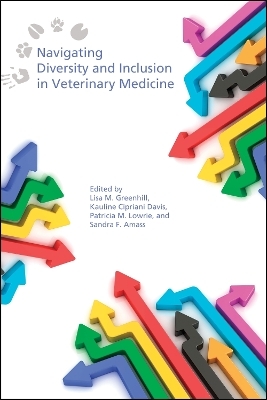
Navigating Diversity and Inclusion in Veterinary Medicine
Purdue University Press (Verlag)
978-1-61249-668-9 (ISBN)
- Titel z.Zt. nicht lieferbar
- Versandkostenfrei innerhalb Deutschlands
- Auch auf Rechnung
- Verfügbarkeit in der Filiale vor Ort prüfen
- Artikel merken
This book addresses the continued lack of the diversity in veterinary medicine, the least inclusive of all medical professions. Effective navigation of the complexity of diversity and inclusion in veterinary medicine requires clear enumeration, recognition, and understanding of key issues, challenges, and opportunities. In a nation with rapidly changing demographics, public needs and expectations of the veterinary profession will continue to evolve. A more diverse scientific workforce is required to feed the veterinary profession, not just for the purposed of equity, but as necessity for its sustainability and relevance.The book lays out the history of diversity in the veterinary profession, in the context of historical changes and actions within US society. An overview of selected strategies from dental, pharmacy, and (human) medical schools is then offered. The impact of social constructs on career interest development is explored using the examples of race, gender, sexual orientation, and gender identity. Practical strategies for attracting preschool through undergraduate students to careers in the veterinary profession are presented, as well as metrics and tools to assess the impact of diversity and inclusiveness strategies. A systems approach to diversity and inclusiveness in the veterinary profession is called for in a manner that frames barriers as opportunities for improvement and progress. There is much that needs to happen to achieve professional inclusiveness and cultural competency, but the path to achieving this is clear. System-wide commitment, planning, execution, and continuous assessment will position the profession to better suit the population of the nation and the world that will be served. This is book is a call to action for consistent championship and cohesive approaches, and it provides a road map to building a sustainably inclusive future.
Lisa M. Greenhill is the Associate Executive Director for Institutional Research and Diversity for the Association of American Veterinary Medical Colleges. Her work primarily focuses on the ongoing development and implementation of the DVM: DiVersity Matters initiative at the national and local levels as well as promoting the veterinary medical profession within communities of colour. Greenhill is the recipient of the Emerging Leader Award from the National Association of Minority Medical Educators, Inc. Kauline Cipriani Davis is the Director of Diversity Initiatives at the Purdue School of Veterinary Medicine. She is responsible for developing, implementing and coordinating initiatives to enhance diversity and inclusiveness. Patricia M. Lowrie is the Assistant to the Dean in the College of Veterinary Medicine and is also the Director of the Women's Resource Center at Michigan State University. She is the recipient of the MSU University Diversity Award, and she was recently recognized by the Association of American Veterinary Colleges for her contributions to veterinary medical education. Lowrie currently is a senior fellow at the Association of American Colleges and Universities and serves as chairperson of the advisory board for Campus Women Lead. Sandra F. Amass is the Associate Dean for Engagement and a professor of veterinary clinical sciences at the Purdue School of Veterinary Medicine. She is a co-PI on the Fat Dogs and Coughing Horses Program, a cooperative effort funded by NIH/NCRR/SEPA to develop educational programs for P-12 students.
Foreword. What It Means to Be Inclusive and Why It Is Imperative for the Veterinary Profession, by Willie M. Reed
Preface
Chapter 1. The Base Map: What Is the Case for Inclusion?, by Lorelle L. Espinosa and Lisa M. Greenhill
Chapter 2. The Aerial Mosaic: A Historical Picture of Diversity in Veterinary Medicine, by Billy E. Hooper
Chapter 3. Orientation: Looking at Strategies Utilized by Other Health Professions for Increasing Diversity, by Kauline Cipriani Davis
Chapter 4. Origin of Coordinates: The Dilemma of Social Constructs, by Patricia M. Lowrie, Lisa M. Greenhill, Mangala Subramaniam, and Ken Gorczyca
Chapter 5. Mapping Our Future: Developing the Pipeline for a Diverse Workforce, by Sandra F. Amass, Omolola Adedokun, Kauline Cipriani Davis, and Dorothy A. Reed
Chapter 6. The Land-Line Adjustment: How Do We Measure Impact?, by Kauline Cipriani Davis and Lisa M. Greenhill
Chapter 7. "Here Be Dragons": Barriers to and Opportunities for Change, by James W. Lloyd
Chapter 8. The View at 40,000 Feet: Networking a Diverse Profession, by W. Ron DeHaven
Government, by Bernadette M. Dunham and Mary E. Allen
Corporate Veterinary Medicine, by Clinton A. Lewis
Academia, by Ronnie G. Elmore, James R. Coffman, and Ralph C. Richardson
Veterinary Students, by Cara E. Williams
Chapter 9. Dead Reckoning: A Call to Action, by Patricia M. Lowrie and Lisa M. Greenhill
Appendix A: Representative Summary of P-12 Programs at Schools and Colleges of Veterinary Medicine
Appendix B: Representative Summary of Undergraduate Programs at Schools and Colleges of Veterinary Medicine
Editor and Author Bios
Index
| Erscheinungsdatum | 26.10.2020 |
|---|---|
| Verlagsort | West Lafayette |
| Sprache | englisch |
| Maße | 152 x 229 mm |
| Gewicht | 333 g |
| Themenwelt | Medizin / Pharmazie ► Allgemeines / Lexika |
| Sozialwissenschaften ► Ethnologie | |
| Sozialwissenschaften ► Pädagogik ► Erwachsenenbildung | |
| Sozialwissenschaften ► Soziologie | |
| Veterinärmedizin | |
| ISBN-10 | 1-61249-668-7 / 1612496687 |
| ISBN-13 | 978-1-61249-668-9 / 9781612496689 |
| Zustand | Neuware |
| Informationen gemäß Produktsicherheitsverordnung (GPSR) | |
| Haben Sie eine Frage zum Produkt? |
aus dem Bereich


